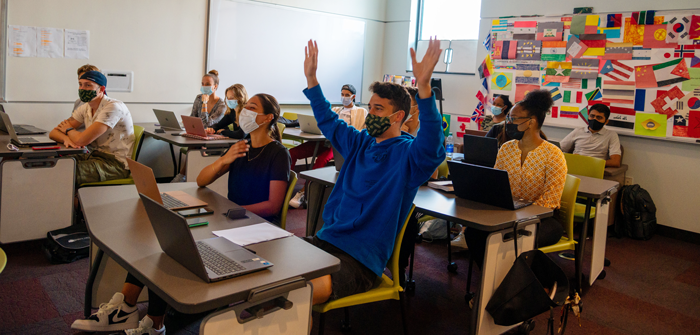Saint Leo University Program for Second-Language Learners from Abroad Satisfies Distinct Needs
Instruction boosts international students' command of academic English and helps them adapt to American campus life, leading to greater college success.

Instruction boosts international students' command of academic English and helps them adapt to American campus life, leading to greater college success.

About 275 new international students from 50 countries arrived at University Campus within the last two weeks for the Fall 2021 Semester and the start of their college careers.
For these students, college can be an even larger investment than for their American counterparts, but they are looking forward to ample rewards. "The U.S. higher education system is considered the top quality in the world," said Dr. Iona Sarieva, an associate professor in the Department of Language Studies and the Arts. And many American colleges and universities are eager to enroll students who want to come to the United States for study, Sarieva added.
But not all international students who are otherwise academically qualified for college arrive with the level of English language skills required not just to converse, or follow American television shows, but to comprehend their textbook readings, write college-level papers in English, and participate in thoughtful classroom discussions or study groups and advising and tutoring sessions. Students from Puerto Rico may also encounter this situation as Spanish is more prevalent, even though English is also one of the official languages of the U.S. territory.
Students' results on a standardized academic test of English proficiency help indicate whether they will need a stronger command of English for academic purposes.
Saint Leo has developed a curriculum called the Bridge Program and Sarieva directs it. The Bridge Program has been helpful to students whose first languages have been Spanish, another European based language, Chinese, and Korean, among others.
(Saint Leo's virtual Campus Tour is available in English, 한국어, 中文, Português, and Español (https://www.youvisit.com/tour/saintleo)
The program has become increasingly effective since it was first launched in 2012, Sarieva said, and it compares favorably with English-acquisition programs at other colleges and universities. Domestic students benefit from the success of this program as well, Sarieva contended, as it helps internationalize the Saint Leo campus.
This year, the Bridge Program will reach some new milestones. Twenty-two undergraduates are enrolled. In a new development, seven graduates enrolled in the program (and are treated as continuing undergraduates for tuition-payment purposes), and will then proceed into graduate studies at Saint Leo's Tapia College of Business.
Some of the key facts about the program and its requirements are:
Bridge Program students' experiences
In addition to statistics that testify to the effectiveness of the Bridge Program, Sarieva points to the experiences of students who say they gained confidence through the program and made lasting friendships.
Doriann Pina, for instance, a sophomore this year, reported feeling better equipped to tackle her academic goals after her Bridge studies last year. She came to Saint Leo to earn a degree in biology, specifically in the biomedical and health sciences track—a challenging program. Although Pina was born in the United States, she was raised in Cape Verde, a nation of islands off the coast of West Africa where Portuguese is the dominant language. She learned English growing up by studying "music, books, movies, and shows" and practicing. After she arrived at Saint Leo, however, she felt overwhelmed and confused and decided that she needed "more guidance and more improvement on my English skills before I started my major."
She still had anxieties when she arrived at the classroom for her first Bridge class, but recalled that Sarieva put the class at ease when she welcomed them. The program helped her academically, socially, and culturally, she said. "The professors were very patient, friendly, competent, and always willing to help with whatever I needed." She had new friends from Haiti, Vietnam, Italy, and Qatar.
After her second semester at Saint Leo, Pina was accepted into the university's Honors Program for high-achieving students, which has a focus on global citizenship. She also helps other students with her major in Bridge.
One student, from Syria, was actually afraid to speak much when he first arrived on campus. The program helped him overcome worries about making mistakes and allowed him to focus on the progress he was making, he said. His name is Ammar Mohrat and he ended up being a student speaker in 2018 for his undergraduate commencement. He works in the technology industry today.
Benefits of international experiences for U.S. students
Sarieva said that American students at University Campus also benefit from the presence of the Bridge Program. Because it allows Saint Leo to attract more international students, she said, it advances the diversity of the campus. "It adds to the strength of the community," she said.
As today's students enter the workforce, she explained, they will also reap benefits from having studied and lived with people from other cultures. They will have learned, from a young age, that people from different cultures and nations can collaborate, a point she considers essential for career success. "We are living in a globalized world."